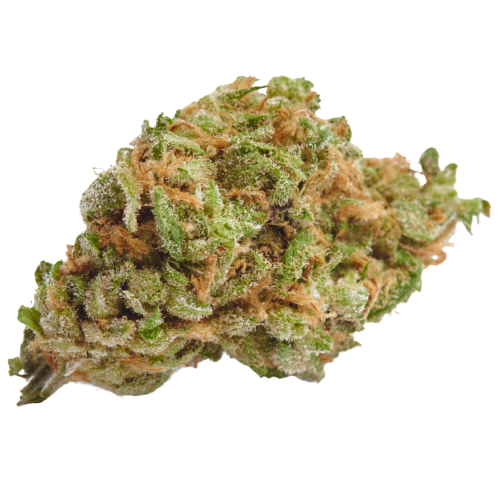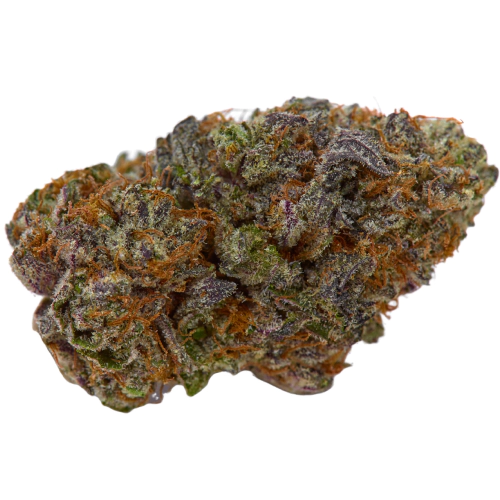THC 17 - 25.5%
CBD 0.21 - 1.14%
Effect Tingly
Flavor Pungent
22 - 22%
0.53 - 0.74%
0.1 - 0.11%
Grape, Earthy
Happy
While the breeder of Lemon Sweet Skunk strain is unknown, this 100% Sativa cannabis is a Lemon and Island Sweet Skunk child strain.THC levels are 22%, with CBD levels not exceeding 0.7%. The terpene profile will delight lovers of citrus and mint strains, as it contains Pinene and Limonene. And even though the aroma may seem very appealing, beginners should be careful when smoking this weed.
Experienced smokers will note the refreshing menthol scent that only enhances the Sativa's effects. A mix of lemon and lime flavors with hints of pine will make you feel uplifted and energized.
Since this is a 100% Sativa weed, almost all users report the excellent energizing properties of this marijuana. Experienced smokers say it has a very buzzing effect, giving a powerful cerebral high. Also among the main effects are:
This weed strain is a great painkiller and can help relieve symptoms of the following ailments:
But due to the high level of THC and potency, side effects are possible, among which dry mouth is most common, but also likely:
Cultivators claim that Lemon Sweet Skunk cannabis strain is easy enough to grow, but finding its seeds on the internet will be quite difficult. These buds can be grown both outdoors and indoors and will average 8-9 weeks flowering time. Under the right conditions, plants will yield 1-2 oz / ft2 when grown indoors and the same per plant when grown outside.
| THC | Tetrahydrocannabinol, or THC, is a major cannabis chemical compound. It is a psychoactive element that stimulates dopamine release and induces euphoria or happiness. THC-rich strains may be helpful with such conditions as lack of appetite, chronic pains , etc. It is considered to be the primary active marijuana component. | 22 - 22% |
| CBD | Cannabidiol, or CBD, is a major compound in cannabis, which is non-psychoactive. It is also proved to counteract the side effects of the second major component THC. CBD is widely used for medicinal purposes in rubs, oils and so on. It is helpful in muscle pain cases, may treat arthritis and migraines. Even Greeks used it against pain, while Queen Victoria applied it to get rid of menstrual cramps. | 0.53 - 0.74% |
| CBC | Cannabichromene, or CBC, is a minor cannabinoid, meaning that its quantity in cannabis is quite little. Though it has the same origin as CBD and THC, it is different in functions. Without any psychoactive effects, it is an efficient cannabis compound in combating acne and depression. CBC produces analgesic, antibacterial and anti-inflammatory effects. | 0.11 - 0.14% |
| CBG | Cannabigerol, or CBG, is one of the minor cannabis compounds in adult plants. On the other hand, young ones contain a lot of this antibacterial and anti-inflammatory component. During the growth, CBG is converted into different cannabinoids, mostly THC and CBD. The compound itself increases appetite and decreases eye pressure. | 0.1 - 0.11% |
| CBN | Cannabinol, or CBN, is a trace element in cannabis that is considered to be mildly psychoactive. It appears from oxidation THC, exposed to light and heat. CBN is mostly contained in old cannabis and in traditional hashish. It is effective against insomnia, bacterial infections and appetite loss. | 0.04 - 0.28% |
| THCV | Tetrahydrocannabivarin, or THC-V, is a compound contained in cannabis in trace amounts. Even though it is close to THC molecularly, it is different in effects. This compound may be psychoactive only in large amounts. THC-V reduces blood sugar, controls appetite, stimulates bone growth, etc. African Sativa strains are the richest in THC-V. | 0.23 - 0.37% |
| Pinene | Pinene is one of the most widespread terpenes in nature, found in pine trees, basil, nutmeg, parsley, and rosemary. Cannabis containing terpene (alpha-pinene or α-pinene) boasts a strong pine scent. Pinene is responsible for anti-inflammatory, pain-relieving, and anti-anxiety effects. | 0.24% |
| Myrcene | Myrcene (also known as β-myrcene) is one of the most common terpenes found in cannabis, representing more than 20% of the modern marijuana terpene profile. Myrcene has a distinct earthy, musky flavor, resembling cloves. It is responsible for calming and soothing effects of weed. Myrcene is also found in hops, thyme, mango, lemongrass, guava melon. | 0.22% |
| Humulene | Humulene (also known as α-humulene) is one of the major terpenes found in cannabis, contributing to woody, earthy, spicy, herbaceous, and, mainly, floral aromas of cannabis. Used in modern medicine, humulene offers anti-inflammatory, antibacterial, and appetite suppressant effects, which have been well-researched by pharmaceutical companies. | 0.03% |
| Limonene | Limonene (also known as d-limonene) is the second most common terpene in nature and the third most common terpene in cannabis. It has a powerful citrus aroma and can be found in all citruses, including lemons, oranges, grapefruits, limes, juniper, etc. Limonene is known to elevate moods and provide anxiety, depression, and stress relief. | 0.19% |
| Linalool | Linalool (also known as beta linalool, linalyl alcohol, linaloyl oxide, and p-linalool) is one of the rarest terpenes found in cannabis, mostly in small quantities. Linalool is known for its spicy and lavender aroma, bringing relaxation and calming effects. It is also said to provide anti-inflammatory and analgesic properties that can be useful for athletes. | 0.19% |
| Pulegone | Pulegone is a less-common terpene found in peppermint and catnip, for example, with a sweet and minty aroma. In small amounts, pulegone could be found in some cannabis strains. It is reported to offer anxiety-relieving effects, increased cognitive performance, and sedative properties. Could remove dizziness. | 0.03% |
| Terpinolene | Terpinolene is one of the most common terpenes found in cannabis; however, It's usually presented in small quantities. Is responsible for piney, floral, herbaceous, and even a little bit citrusy aroma of cannabis. Terpinolene can be found in lilacs, nutmeg, and cumin. In cannabis, terpinolene contributes to the sensation of "freshness." Has the potential to reduce the risk of heart diseases. | 0.06% |
| Caryophyllene | Caryophyllene (also known as beta or b caryophyllene) is a terpene found in many herbs and spices, such as black pepper, basil, rosemary, and oregano. Cannabis high in caryophyllene delivers a strong spicy, peppery aroma, resembling cinnamon and cloves. Caryophyllene offers potent anti-inflammatory and sedative effects. | 0.04% |
| Total terpenes content | 1.00% |
THC 17 - 25.5%
CBD 0.21 - 1.14%
Effect Tingly
Flavor Pungent
THC 15 - 19%
CBD 0.77 - 0.97%
Effect Talkative
Flavor Sweet
THC 17.67 - 21.33%
CBD 0.53 - 1.1%
Effect Concentrated
Flavor Earthy
THC 15.75 - 19%
CBD 0.36 - 1.12%
Effect Euphoric
Flavor Violet
THC 16.83 - 20.17%
CBD 0.42 - 0.69%
Effect Relaxed
Flavor Spicyherbal
THC 15 - 21%
CBD 0.39 - 0.82%
Effect Hungry
Flavor Lime

THC 20.25 - 24.5%
CBD 0.49 - 0.94%
Effect Sleepy
Flavor Diesel

THC 8.6 - 10.2%
CBD 11.2 - 12.1%
Effect Relaxed
Flavor Sweet
THC 22 - 26%
CBD 0.22 - 0.33%
Effect Focused
Flavor Spicyherbal
THC 7.38 - 9.88%
CBD 0.01 - 0.28%
Effect Tingly
Flavor Citrus
THC 21.33 - 23.33%
CBD 0.13 - 0.53%
Effect Uplifted
Flavor Sweet
THC 15.5 - 18.75%
CBD 0.2 - 0.36%
Effect Tingly
Flavor Flowery
THC 20 - 27%
CBD 0.08 - 0.21%
Effect Euphoric
Flavor Spicyherbal
THC 14 - 20%
CBD 0.05 - 0.23%
Effect Concentrated
Flavor Blue cheese
THC 18.5 - 21%
CBD 0.16 - 0.28%
Effect Tingly
Flavor Lemon
THC 20 - 24%
CBD 0.33 - 0.43%
Effect Giggly
Flavor Spicyherbal
THC 23.17 - 25.5%
CBD 0.32 - 0.65%
Effect Giggly
Flavor Butter
THC 15 - 22.5%
CBD 0.47 - 1.32%
Effect Giggly
Flavor Pine
THC 19.2 - 21.6%
CBD 0.57 - 0.91%
Effect Euphoric
Flavor Citrus
THC 14.5 - 24%
CBD 0.18 - 6.31%
Effect Concentrated
Flavor Apple
Be the first and share your opinion
Write a Review